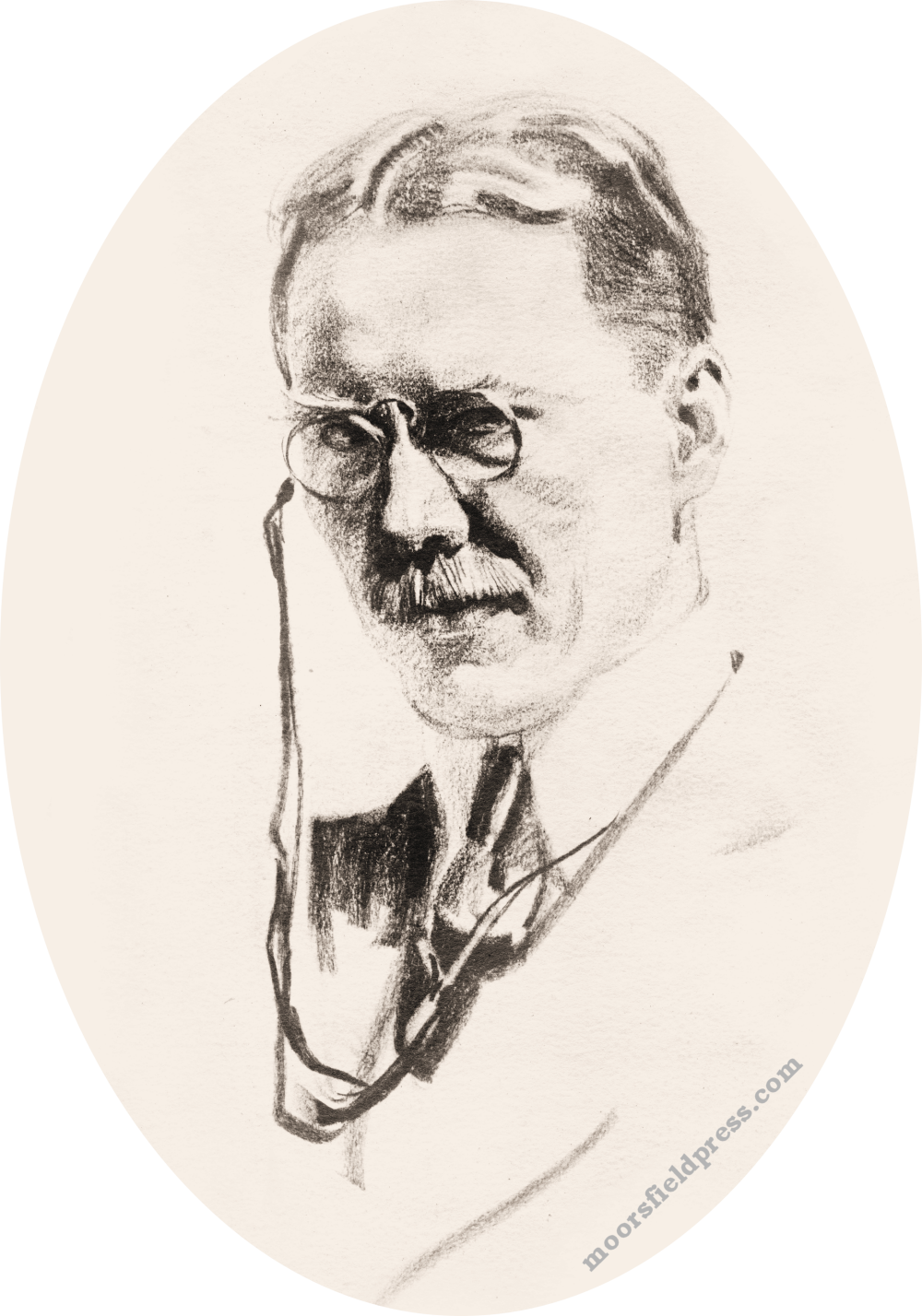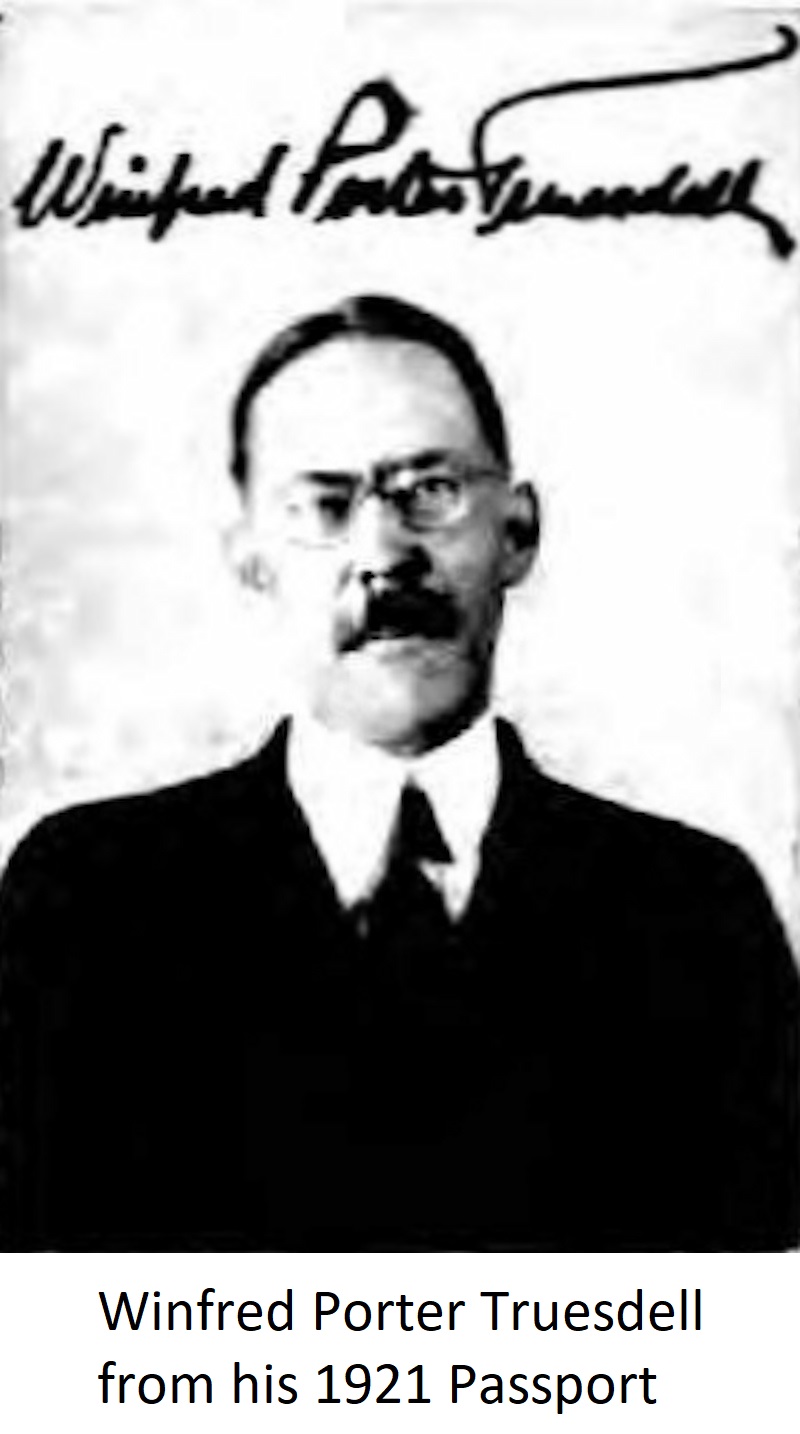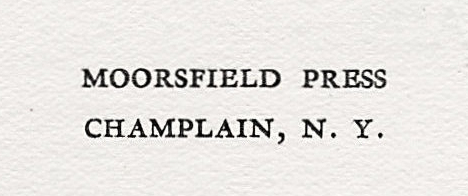|

Winfred Porter
Truesdell:
Champlain's
International Art Publisher
by David Patrick
Winfred Porter
Truesdell was an internationally known art
publishe r who
lived in the Village of Champlain, New
York. He amassed a collection of thousands of
bookplates, lithographs and photographs and
published many books related to printing between
the years 1903 and 1933. His best-known
publication was an
art magazine called "The Print Connoisseur"
which he printed between 1920 and 1932.
Truesdell started printing near Boston but moved
to New York City and then to
Champlain, New York, where he lived for 18
years. It is likely that
many people today have never heard of
Truesdell. He is certainly Champlain's unknown art
publisher. r who
lived in the Village of Champlain, New
York. He amassed a collection of thousands of
bookplates, lithographs and photographs and
published many books related to printing between
the years 1903 and 1933. His best-known
publication was an
art magazine called "The Print Connoisseur"
which he printed between 1920 and 1932.
Truesdell started printing near Boston but moved
to New York City and then to
Champlain, New York, where he lived for 18
years. It is likely that
many people today have never heard of
Truesdell. He is certainly Champlain's unknown art
publisher.
Truesdell was an art
connoisseur at an early age. By 1901, at
the age of 24, his passion was collecting
printed bookplates. His first wife Amy
also had an interest in bookplates and designed
some herself.
What is a "bookplate?"
It is essentially a printed label that the owner
of a book would use to indicate to others,
especially if the book was loaned, who the book
belonged to. Instead of writing the name
of the owner in the book, book owners could
easily paste a printed label in the book with
their name on it. The bookplate evolved
over time to encompass elaborate, custom designs
that were made by engraving copper or zinc
plates similar to that of lithograph
prints. A number of noted engravers
created bookplates for people who could afford
one.
Truesdell lived near Boston
where many bookplate artists and collectors
lived. He contributed articles to national
and international magazines devoted to bookplate
collecting. Between the years 1902 and
1908, he is mentioned numerous times in the
periodical "Journal of the Ex Libris Society"
which was published in England ("ex libris"
is Latin for "bookplate"). The editor
noted the high quality of his 5,000-piece
collection.
Around 1903, Truesdell
purchased a printing press and called his
publishing business the "Troutsdale
Press." Between 1903 and 1907, he
published 12 booklets that showcased the work of
various bookplate artists. After 1907,
Truesdell's interests in bookplates appears to
have waned. He was now interested in a
similar field: engraving and lithography.
During the 1910's Truesdell
focused his work on American and European
engravers who made beautiful lithograph
prints. Publishing at the time relied on
artist-engravers to reproduce portraits,
paintings, drawings and historic scenes in
astonishing detail using engraved copper plates,
etched zinc plates, blocks of wood or even
carved linoleum. The engraved plates were
used in a printing press for mass production of
the image. Some artists printed in color
using the aquatint or mezzotint methods.
Over the next 30 years, Truesdell collected over
9,000 lithograph prints, some of them in
color. He bought many prints on three
European vacations in the early 1920s. His
New York City studio partner was Englishman
Frederick Reynolds who was a famous mezzotint
printer of fine prints.
"The Print Connoisseur"
Magazine
Starting in October of 1920, Truesdell printed a
quarterly magazine called "The Print
Connoisseur" which was devoted to
articles related to engravings and engravers,
print makers and artists. The magazine ran
from 1920 to 1932 and comprised 46 issues.
Truesdell's Print
Connoisseur magazine usually had four or
five articles written by guest writers.
Truesdell sometimes wrote one or two articles
himself for an issue. The magazine included high
quality prints made from engravings or wood
cuts. Most magazine covers were printed in
black and white but some were printed in
color. Truesdell supported his magazine
through subscriptions and ads.
Truesdell's studio was
originally in New York City when he started
printing The Print Connoisseur in
1920. In 1922 and 1923, he had the Clinton
Press in Plattsburgh print the magazine while he
was in the process of moving to Champlain or
traveling in Europe. Between 1924 and 1926
Hugh McLellan of Champlain used his newly
established Moorsfield Press to print the
magazine. Afterwards, Truesdell printed
them himself.
Truesdell's Book Publishing
(1924-1933)
In 1924, Truesdell published his first large
book on the work of artist and engraver Charles
Meryon which was written by Loys Delteil (who
also contributed articles to his
magazine). Other books followed for the
work of engravers Henry Wolf (1927) and Gustav
Kruell (1929), both books written by Ralph
Clifton Smith.
Truesdell was considered an
authority on George Washington, Abraham Lincoln
and the Civil War and often gave talks on these
subjects. In 1926 and 1927, he published
several important books related to the
lithographs of Col. Elmer E. Ellsworth, the
first northern soldier killed in the Civil
War. Truesdell's Ellsworth books were an
expansion of the articles printed in his Print
Connoisseur magazine in April and July of
1926.
Truesdell spent many years
collecting Abraham Lincoln lithographs. In
1916, he planned to publish all of the portraits
and engravings of Abraham Lincoln. He was
in discussions with Frederick Hill Meserve
(1865-1962) to use prints of Meserve's Lincoln
photographs for his upcoming book. In
1911, Meserve had published his authoritative
book on all of the Lincoln photographs known to
exist. Truesdell wanted to print a similar
book and Meserve offered him 112 prints from his
exclusive negatives. Four years later, in
1920, Truesdell printed an announcement for the
upcoming book but it wouldn't be until 1933
before he printed Volume 2 of the planned
four-volume series. Truesdell died before
printing the other three volumes.
The McLellan Lincoln Collection
In 1918, Hugh McLellan semi-retired from the
architectural business in N.Y.C. and moved back
to Champlain to settle his father's
estate. His father, Charles Woodberry
McLellan, had been a friend of Abraham Lincoln
and Robert Todd Lincoln from 1856 to 1860 in
Springfield, Illinois, and continued his
friendship with Robert up to his death. At
the end of his life, Charles was one of the top
five Lincoln collectors in the country (known as
one of the "Big Five.") His Lincoln
collection was stored in a large, fire proof
vault in the McLellan cottage and contained many
letters written by Lincoln from 1838 to 1865.
The most important letter he owned was a reply
by Lincoln to the Thomas Jefferson Day Dinner
celebration in Boston in 1858. Lincoln was
unable to attend, but his letter, really a
speech, was read at the dinner and is said to
have helped him win the East. Hugh
McLellan printed the letter in 1923 with his
Moorsfield Press for Commencement weekend at
Brown University.
Truesdell was interested in
McLellan's Lincoln collection and visited
Champlain several times to see it. Over
the next five years, he helped McLellan catalog
the collection, arranged meetings with buyers
and auction houses in N.Y.C. and kept abreast of
similar auctions from the other "Big
Five." He also used some of McLellan's
material for his upcoming Lincoln books.
After negotiating with
various agents and collectors, Hugh and his
brother Malcolm sold their father's collection
to John D. Rockefeller, Jr. in 1923 for $43,500
(worth over $648,000 today). Rockefeller,
in turn, donated it to Brown University where it
is known today as the "Charles Woodberry
McLellan Lincoln Collection."
The Moorsfield Press
When Hugh McLellan founded the Moorsfield Press
in 1919, he had a basic knowledge of printing
from his days at college printing
envelopes. Truesdell had 16 years of
experience working with a printing press and was
also an experienced publisher. He was
instrumental in helping McLellan establish his
press and quickly became his mentor.
McLellan's first publication in 1919
acknowledged Truesdell's assistance: "The
kindly advice of Mr. Winfred Porter Truesdell
in the typography of this brochure, and his
assistance and encouragement, are gratefully
acknowledged."
Starting in the early
1920s, Truesdell went to Europe three times
in search of art and to sell ads for his
magazine. He asked McLellan to help
with the production of his magazine which
was now being printed by the Clinton Press
in Plattsburgh. He needed McLellan to
manage his affairs, pay bills, handle
printing problems and correspond with
authors. McLellan found his hands full
handling Truesdell's magazine printing and
overdue bills. This left little time
for his own printing business.
Truesdell Moves to
Champlain
In 1922, Hugh McLellan suggested to Truesdell
that he move to Champlain and establish his own
press. Truesdell quickly realized that it
would be cheaper to live in Champlain than in
New York City. He knew that he did not
have to pay rent for an apartment or office
space as he was using the same space as
McLellan's press. He spent the next
year moving his printing equipment and was
permanently in Champlain by Christmas of
1923. He stayed in
an empty house that McLellan owned.
Between 1924 and 1927,
Truesdell printed the Print
Connoiss eur
at the Moorsfield
Press with the help of Hugh McLellan.
These editions show the unique
style of the Caslon old-style font. It is
the same font that McLellan would use when he
issued his own historical magazine called the "Moorsfield
Antiquarian" in 1937 and 1938 as well as
many historical pamphlets. eur
at the Moorsfield
Press with the help of Hugh McLellan.
These editions show the unique
style of the Caslon old-style font. It is
the same font that McLellan would use when he
issued his own historical magazine called the "Moorsfield
Antiquarian" in 1937 and 1938 as well as
many historical pamphlets.
Truesdell's Life, Education and
Marriage
Winfred Porter Truesdell was born on November
13, 1877, in Lynn, Massachusetts.
According to Woody McLellan, who was the son of
Hugh, Truesdell "was a self-educated man,
never having obtained a formal high school
education, yet he spoke French and Spanish
fluently and became popular as an after-dinner
speaker." He also described him as a
"remarkably brilliant man." Woody
knew Truesdell since the early 1920s and worked
with him at the press as a teenager.
After Truesdell moved to
Champlain, he met school teacher Edythe
Gettys. They married in August of 1924 and
lived on Oak St. in Champlain. On May 27,
1939, Truesdell died at his house of a heart
attack after being ill for a year. He was
buried in the Glenwood
Cemetery in Champlain.
After Truesdell died, his
wife Edythe never moved his books or his
printing press. Hugh McLellan noted that the
work he put into preparing his four Lincoln
volumes was wasted as only one volume was
printed (McLellan thought that a second volume
might have been printed or was in the process of
being printed).
In March of 1942, Dr. Louis A.
Warren, Director of the Lincoln National Life
Foundation, visited Champlain and met Hugh
McLellan and Edythe Truesdell. He
purchased Truesdell's Lincoln and Civil War
collection for the foundation. A short
note was printed in the foundation's Lincoln
Lore newsletter (September
20, 1943) about the purchase. This
edition also noted other Lincoln collections
that were purchased over the years:
Winifred [sic] P.
Truesdell, Champaign [sic], N. Y.
1942
Winifred Porter Truesdell was one of America's
leading picture experts and editor of The
Print Connoisseur. His ambitious
undertaking to make available in four printed
volumes a compilation of all known Lincoln
prints was never fully realized. One volume,
however, was completed and data for a second
compiled before he passed away. Aside from his
collection of pictures which has greatly
enriched the illustrative material in the
Foundation, his library of Lincoln books and
pamphlets have contributed much to the
reference value of the Foundation's
Lincolniana.
When Edythe Truesdell died in 1970, several
heirs settled her estate and disposed of
Truesdell's art collection, books, printing
press and house. Most of his bookplates,
magazines, lithographs and photographs were
donated to Special Collections, Feinberg Library
at SUNY-Plattsburgh by the Fall of 1971 and
encompassed approximately 9,381 items.
General art books were placed in the main
collection. Today, the collection of
lithographs and photographs have been indexed
and are available for researchers.
A Side-Note
In 1945, Hugh McLellan was one of the founding
members of the Clinton County Historical
Association as well as President. His son
Woody published the North Country Notes
newsletter using the Moorsfield Press starting
in 1960.
(PDF format)
|

 r who
lived in the Village of Champlain, New
York. He amassed a collection of thousands of
bookplates, lithographs and photographs and
published many books related to printing between
the years 1903 and 1933. His best-known
publication was an
art magazine called "The Print Connoisseur"
which he printed between 1920 and 1932.
Truesdell started printing near Boston but moved
to New York City and then to
Champlain, New York, where he lived for 18
years. It is likely that
many people today have never heard of
Truesdell. He is certainly Champlain's unknown art
publisher.
r who
lived in the Village of Champlain, New
York. He amassed a collection of thousands of
bookplates, lithographs and photographs and
published many books related to printing between
the years 1903 and 1933. His best-known
publication was an
art magazine called "The Print Connoisseur"
which he printed between 1920 and 1932.
Truesdell started printing near Boston but moved
to New York City and then to
Champlain, New York, where he lived for 18
years. It is likely that
many people today have never heard of
Truesdell. He is certainly Champlain's unknown art
publisher.  eur
at the Moorsfield
Press with the help of Hugh McLellan.
These editions show the unique
style of the Caslon old-style font. It is
the same font that McLellan would use when he
issued his own historical magazine called the "Moorsfield
Antiquarian" in 1937 and 1938 as well as
many historical pamphlets.
eur
at the Moorsfield
Press with the help of Hugh McLellan.
These editions show the unique
style of the Caslon old-style font. It is
the same font that McLellan would use when he
issued his own historical magazine called the "Moorsfield
Antiquarian" in 1937 and 1938 as well as
many historical pamphlets. 